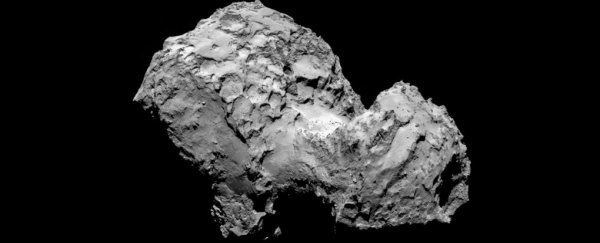As cosmic bodies like planets and comets form, it's thought that magnetism plays a critical role in pulling all the dust particles and rocks together.
While we know that most planets have magnetic fields, which extend from their core up intospace to protect the surface against solar winds and radiation, we haven't been able to verify that comets have the same magnetic fields.
This changed in November 2014, when the European Space Agency's Rosetta mission made history by landing its Philae probe onto the surface of a 4-km-wide comet known as 67P/Churyumov-Gerasimenko. During this nearly two-hour sequence, both spacecraft took measurements of the comet's magnetic field using specialised equipment.
Scientists have now analysed the data, and have found that the 67P comet does not have a magnetic field.
"It's a massively important finding and a key thing we wanted to measure," Matthew Taylor, the ESA's project scientist for Rosetta, told Quirin Schiermeier at Nature.
"That Churyumov-Gerasimenko does not have a magnetic field could help us solve the puzzle of how planetary building blocks evolved from the proto-planetary disk. It appears we will have to switch off the effect of magnetism in simulations of the beginning."
Finding magnetism on comet 67P could have supported the theory that magnetic attractions played an important role in the assembly of comets and proto-planets in the early Solar System. But the new data appear to rule that theory out - at least to a degree.
The findings were described at a meeting of the European Geosciences Union in Austria this week, and an accompanying report has also been published in the journal Science.
Using the data from the respective spacecraft, the ESA team has been able to recreate the landing sequence of the Philae probe, which came into contact with the comet's surface four times before ultimately coming to a stop.
Jonathan Amos from the BBC described the landing:
"Famously, the robot bounced, and data indicates that after a period of 46 minutes, and after covering a distance of some 630 metres, Philae made its next contact with the surface. But this is clearly a glancing blow with a cliff structure, because the interpretation of the data is that the robot starts tumbling.
A further 600 metres into its unexpected journey across the comet, Philae made a more solid touchdown, before briefly lifting up again and coming to rest, finally, in the dark ditch it managed to photograph just prior to running out of battery power. From first to fourth contact is a separation of 117 minutes."
It probably wasn't the smooth landing ESA engineers had hoped for, but it actually proved quite beneficial for the purpose of data collection.
"The unplanned flight across the surface actually meant we could collect precise magnetic field measurements with Philae at the four points we made contact with, and at a range of heights above the surface," lead author Hans-Ulrich Auster said in a press release.
This allowed the researchers to compare more measurements, and ultimately, to determine that the strength of the field did not depend on the height or location of Philae above the surface. Had the comet had a magnetic field, they would have expected to see a clear increase in the magnetic readings the closer the lander got to the surface.
"But this was not the case at any of the locations we visited, so we conclude that Comet 67P/Churyumov-Gerasimenko is a remarkably non-magnetic object," said Auster.
The results don't rule out the possibility that magnetism may play an important role in the earliest stages of planet or comet growth, pulling together small dust particles, but they make it implausible that magnetism furthers the growth of bodies once they have reached a certain size, Auster told Nature.
The next hurdle for the Rosetta mission is re-establishing contact with the lander, which lost power after 64 hours on the comet, and is believed to be in a very cold, shaded area. As the comet moves closer to the Sun in the next three to four months, it could power-up and send a signal. We hope, for the sake of science, that it does.
